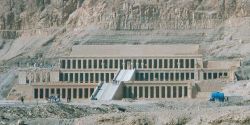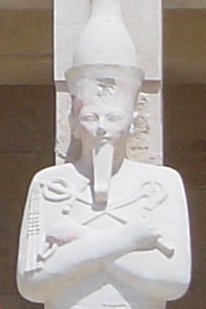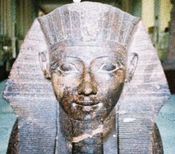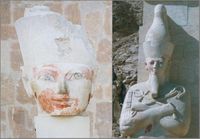Hatshepsut
2007 Schools Wikipedia Selection. Related subjects: Historical figures
| Persondata | |
|---|---|
| NAME | Hatshepsut |
| ALTERNATIVE NAMES | Hatchepsut |
| SHORT DESCRIPTION | Pharaoh of Egypt |
| DATE OF BIRTH | {{{Birth}}} |
| PLACE OF BIRTH | Ancient Egypt |
| DATE OF DEATH | {{{Death}}} |
| PLACE OF DEATH | Ancient Egypt |
Maatkare Hatshepsut or Hatchepsut was the fifth pharaoh of the Eighteenth dynasty of ancient Egypt. She was believed to have been co-regent from about 1479 to 1458 BC (years 7 to 21 of Thutmose III) . She is regarded as the earliest known queen regnant in history and as the first great woman in recorded history. She was only the second known woman to assume the throne as "King of Upper and Lower Egypt" after Queen Sobekneferu of the 12th Dynasty of Egypt.
Family and early life
Hatshepsut was the eldest daughter of Thutmose I and Queen Ahmose, the first king and queen of the Thutmosid clan of the 18th Dynasty. Thutmose I and Ahmose are known to have had only one other child, a daughter Akhbetneferu (Neferubity), who died in infancy. Thutmose I also married Mutnofret, possibly a daughter of Ahmose I, and produced several half-brothers to Hatshepsut: Wadjmose, Amenose, Thutmose II, and possibly Ramose, through that union. Both Wadjmose and Amenose were prepared to succeed their father, but neither lived beyond adolescence. In childhood, Hatshepsut is believed to have been favored by the Temple of Karnak over her two brothers by her father;a view promoted by her own propaganda. She apparently had a loving relationship with both parents, and produced a propaganda story in which her father Thutmose I supposedly named her as his direct heir (see below) Hatshepsut dressed like a man to prove that she could be Pharoah and Egypt would have many great years under her rule.
Upon the death of her father in 1493 BC, she married Thutmose II and assumed the title of Great Royal Wife. Thutmose II ruled for thirteen years, during which it has been traditionally believed that Hatshepsut exerted a strong influence over him, but he died and only had one son to take his place on the throne. But this was not Hatshepsut's son, as he was the son of a lesser wife named Isis. The boys name was Thutmose III.
Thutmose II had one daughter with Hatshepsut: Neferure. Hatshepsut groomed Neferure as crown prince, commissioning official portraits of her wearing the false beard and side lock of youth. Some scholars speculate that this is evidence that Hatshepsut was grooming Neferure for the throne; others that she was merely planning another Hatshepsut. Whatever her intentions were, they came to nothing as Neferure did not live into adulthood.
Dates and length of reign
Hatshepsut is given a reign of about 22 years by ancient authors. Josephus writes that she reigned 21 years and 9 months, while Africanus states her reign lasted 22 years; both of whom were quoting Manetho. It is also at this point in time that Hatshepsut disappears, as is indicated by the fact that Thutmose III's first campaign was dated to his 22nd year, which would also have been Hatshepsut's 22nd. Dating the beginning of her reign is more difficult, however. Her father's reign definitively began in either 1506 or 1526 BC according to the low and high chronologies, respectively. However, the length of the reigns of Thutmose I and Thutmose II cannot be determined with absolute certainty. With short reigns, Hatshepsut would have ascended the throne 14 years after Thutmose I's coronation. Longer reigns would put her ascention 25 years after Thutmose I's coronation. Thus, Hatshepsut could have assumed power as early as 1512 BC or as late as 1479. Older chronolgies dated her from 1504 to about 1482. Modern chronologers tend to agree that Hatshepsut reigned from 1479 to 1458, but there is no definitive proof either way.
Rule
Upon Thutmose II's death, the throne passed to Thutmose III, and Hatshepsut—as the boy king's aunt and stepmother—was selected to be interregnum regent until he came of age. At first, it appears that Hatshepsut was patterning herself after the powerful female regents of Egypt's then-recent history, but as Thutmose III approached maturity it became apparent that she had only one model in mind: Sobekneferu, the last monarch of the Twelfth dynasty, who ruled in her own right. However, Hatshepsut took one step further than Sobekneferu and had herself crowned pharaoh around 1473 BC, taking the throne name Maatkare.
Hatshepsut surrounded herself with strong and loyal advisors, many of whom are still known today: Hapuseneb, the High Priest of Amun, and her closest advisor, the royal steward Senemut. Because of the close nature of Hatshepsut and Senemut's relationship, some Egyptologists have theorized that Hatshepsut and Senemut were lovers. Among the evidence they offer to support this claim is the fact that Hatshepsut allowed Senemut to place his name and an image of himself behind one of the main doors in Djeser-Djeseru (a rare and unusual sharing of credit), that Senemut had two tombs constructed near Hatshepsut's tomb (this was, however, a standard privilege for close advisors), and the presence of graffiti in an unfinished tomb, used as a rest house by the workers of her mortuary temple, depicting a male and a hermaphrodite in pharaonic regalia engaging in an explicit sexual act. Although the belief that Hatshepsut and Senemut were lovers is well known, it is highly contested among Egyptologists; all that is agreed on is that the steward had ready access to the queen's ear.
As Hatshepsut reestablished the trade networks that had been disrupted during the Hyksos' occupation of Egypt (the Second Intermediate Period), the wealth of the 18th dynasty that has become so famous since the discovery of the burial of Tutankhamun began to be collected. She oversaw the preparations and funding for a mission to the Land of Punt. The expedition set out in her name with five ships, each measuring seventy feet long, and with several sails; each ship accommodated 210 men, including sailors and thirty rowers. Many goods were bought in Punt, notably myrrh, which is said to have been Hatshepsut's favorite fragrance. Most notably however, the Egyptians returned from the voyage bearing thirty-one live frankincense trees, whose roots were carefully kept in baskets for the duration of the voyage. This was the first ever recorded attempt to replant foreign trees. She reportedly had the trees planted in the courts of her Deir el Bahari mortuary temple. She had the expedition commemorated in relief at Deir el-Bahri, which is famous for its unflattering depiction of the Queen of Punt.
Although many Egyptologists have claimed that her foreign policy was mainly peaceful, there is evidence that she led successful military campaigns in Nubia, the Levant and Syria early in her career.
Hatshepsut died, either as she was approaching or just entering middle age, in early February 1482 BC or 1483 BC; no record of her cause of death has survived, although both natural causes and murder have been proposed. Her mummy is believed to be missing from the Deir el-Bahri Cache, and has never been officially identified. An unidentified female mummy—found with Hatshepsut's wet nurse Sitre In and with her arms posed in the traditional burial style of pharaohs—has led to the theory that the unidentified mummy might be Hatshepsut. In March of 2006, Zahi Hawass claimed to have located the mummy of Hatshepsut, which was mislaid on the third floor of the Cairo Museum. Further comment has not been released, however.
Building project

Hatshepsut was one of the most prolific builders of ancient Egypt, commissioning hundreds of construction projects throughout both Upper and Lower Egypt. Under her reign, Egypt's trade networks began to be rebuilt following their disruption during the Hyksos occupation of Egypt in the Second Intermediate Period.
Hatshepsut was a builder pharaoh. As pharaoh she initiated building projects that were grander and more numerous than those of any of her Middle Kingdom predecessors. She employed two great architects: Ineni, who had worked for both her husband and father, and the royal steward Senemut. During her reign so much statuary was produced that almost every major museum in the world has a collection of Hatshepsut statuary; for instance, the Hatshepsut Room in New York City's Metropolitan Museum of Art is solely dedicated to these pieces. Like most pharaohs she had monuments constructed at the Temple of Karnak. She had twin obelisks, at the time the tallest in the world, erected at the entrance to the temple. One still stands today, as the tallest surviving ancient obelisk on earth; the other has since broken in two and toppled. Karnak's Red Chapel, or Chapelle Rouge, was intended as a barque shrine and may have originally stood between the two obelisks. She later ordered two more obelisks to be made to celebrate her sixteenth year as pharaoh. However, one of the obelisks broke while being made, causing a third to be made to replace it. The broken obelisk was left at its quarrying site in Aswan, where it still is today, and has proven valuable in learning how obelisks were quarried.
The masterpiece of her building projects was her mortuary temple complex at Deir el-Bahri. It was designed and implemented by Senemut on a site on the West Bank of the Nile close to the entrance to the Valley of the Kings. The focal point was the Djeser-Djeseru or "the Sublime of Sublimes", a colonnaded structure of perfect harmony nearly one thousand years before the Parthenon. Djeser-Djeseru sits atop a series of terraces that were once graced with gardens. Djeser-Djeseru is built into a cliff face that rises sharply above it. Djeser-Djeseru and the other buildings of the Deir el-Bahri complex are considered to be among the great buildings of the ancient world.
Official propaganda
Hatshepsut was an excellent propagandist, and while all ancient leaders used propaganda to legitimize their rule, she is one of the most known for it. Much of her propaganda had religious overtones supported by the priests at the Temple of Karnak.
In ancient Egypt, women had a higher status than they did elsewhere in the ancient world, including the court-protected right to own or inherit property. Yet having a female ruler in her own right was rare: only Khent-Kaues, Sobeknefru and possibly Nitocris preceded her as ruling in their own name. Pharaoh was an exclusively male title; at this point in Egyptian history there was no word for a Queen regent, only one for Queen consort. Hatshepsut is unique in that she was the first woman to take the title of King regent or King in the absence of a word or title for Queen regent.
Hatshepsut slowly assumed all of the regalia and symbols of the Pharaonic office: the Khat head cloth, topped with an uraeus, the traditional false beard, and shendyt kilt. Many existing statues show her in both a feminine and masculine form. Statues portraying Sobekneferu also combine elements of traditional male and female iconography and may have served as inspiration for the works commissioned by Hatshepsut. However, after this period of transition ended, all depictions of her showed her in a masculine form, with all of the pharaonic regalia and with her breasts omitted. Her reasons for doing this are a topic of great debate in Egyptology. The traditional explanation is that her motivation for wearing men's clothing was sexual. However, most modern scholars believe in a more recent theory: that by assuming the exclusively male symbols of pharaonic power, Hatshepsut was asserting her claim to be King or Queen regnant and not "King's Great Wife" or Queen consort. Even after assuming the male persona, Hatshepsut still described herself as a beautiful woman, often the most beautiful woman, and although she assumed almost all of her father's titles, she declined to take the title "The Strong Bull".
While the queen-pharaoh had herself depicted in art wearing the masculine regalia of the king, such as the false beard, it is most unlikely that she actually wore such ceremonial decorations. Statues such as the ones at the Metropolitan Museum of Art depicting her seated wearing a tight-fitting dress and the nemes crown are a more accurate representation of how she would have presented herself.
One of the most famous pieces of her propaganda is a myth about her birth. In this myth, Amun goes to Ahmose in the form of Thutmose I and wakes her with pleasant odours. At this point Amun places the ankh, a symbol of life, to Ahmose's nose, and Hatshepsut is conceived. Khnum, the god who forms the bodies of human children, is then instructed to create a body and ka, or corporal presence/life force, for Hatshepsut. Khnum and Heket, goddess of life and fertility, lead Ahmose along to a lion bed where she gives birth to Hatshepsut.
To further strengthen her position; the Oracle of Amun proclaimed that it was the will of Amun that Hatshepsut be Pharaoh. She publicized Amun's support by having endorsements by Amun carved on her monuments, for example:
- Welcome my sweet daughter, my favorite, the King of Upper and Lower Egypt, Maatkare, Hatshepsut. Thou art the Pharaoh, taking possession of the Two Lands.
She also claimed that she was her father's intended heir and that he made her crown prince of Egypt. Most scholars see this as revisionism on Hatshepsut's part, but one of her best-known biographers, Evelyn Wells, takes her at her word. Propaganda supporting her claim was commissioned on the walls of her mortuary temple:
- Then his majesty said to them: "This daughter of mine, Khnumetamun Hatshepsut—may she live!—I have appointed as my successor upon my throne... she shall direct the people in every sphere of the palace; it is she indeed who shall lead you. Obey her words, unite yourselves at her command." The royal nobles, the dignitaries, and the leaders of the people heard this proclamation of the promotion of his daughter, the King of Upper and Lower Egypt, Maatkare—may she live eternally
Burial complex
Hatshepsut had begun construction of a tomb when she was the Great Royal Wife of Thutmose II, but the scale of this was not suitable when she became "king", so a second tomb was built. This was KV20, which was possibly the first tomb to be constructed in the Valley of the Kings. The original intention seems to have been to hew a long tunnel that would lead underneath her mortuary temple, but the quality of the limestone bedrock was poor and her architect must have realized that this goal would not be possible. As a result a large burial chamber was created instead. At some point it was decided to inter her father, Thutmose I from his original tomb in KV38 into a new chamber below her own. Her original red-quartzite sarcophagus was altered to accommodate her father instead, and a new one was made for her. It is likely that when she died (no later than the twenty-second year of her reign) she was interred in this tomb along with her father.
The tomb was opened in antiquity, the first time during the reign of Hatshepsut's successor, Thutmose III, who re-interred his grandfather Thutmose I to his original tomb, and then possibly moved Hatshepsut's mummy into the tomb of her wet nurse, In-Sitre, in KV60). Though her tomb had been largely cleared (save for both sarcophagi still present when the tomb was fully cleared by Howard Carter in 1903) some grave furnishings have been identified as belonging to the female pharoah, including a "throne" (bedstead is a better description), a senet game board with carved lion-headed red-jasper game pieces bearing her kingly title, a signet ring, and a partial ushabti figurine bearing her name. In the Royal Mummy Cache at DB320 an ivory canopic coffer was found that was inscribed with the name of Hatshepsut and containing either a mummified liver or spleen. However, there was a lady of the Twenty-first dynasty of the same name, and this could belong to her instead.
Names
As with most pharaohs, Hatshepsut had a number of names. Her birth name, or nomen, was Hatshepsut, to which she suffixed the epithet Khenmetamun, and prefixed the praenomen, or throne name Maat-ka-re. Her names are written as shown in Egyptian hieroglyphs on the right; Maat-ka-re to the top and Hatshepsut to the bottom.
Maat-ka-re means " Ma'at is the ka-spirit of Ra" and Hatshepsut means "Foremost of distinguished women, Joined with Amun". Together they mean "Ma'at is the ka-spirit of Ra, Foremost of distinguished women, Joined with Amun". After she ascended the throne she changed her name from the feminine Hatshepsut to the male Hatshepsu. The names are technically transliterated as m3at-k3-ra H3t-špswt–hnmt-ỉmn.
Hatshepsut and Hatchepsut are the most common spellings of her name, but Hapshepsut and Hat-shep-set are sometimes found.
Changing image
In Egyptology
After her death, many of her monuments were defaced or destroyed. Replacing the names on older monuments with the name of the current ruler was a common practice of pharaohs, but in some cases this is thought to have been an act of damnatio memoriae—condemning a person by erasing him or her from recorded existence. Egyptologists have differing views on who defaced Hatshepsut's monuments and their possible motivations including resentment for the belief that a female Pharaoh was against Ma'at.
The traditional belief is that Thutmose III was responsible, and view the act as revenge for being denied the throne for so long. However, researchers such as Charles Nims and Peter Dorman have examined these erasures and found that those which can be dated were done after the forty-second year of Thutmose's reign, while Donald B. Redford suggests a more sympathetic and complex motivation: Thutmose's need to demonstrate his legitimacy. Redford notes that:
- Here and there, in the dark recesses of a shrine or tomb where no plebeian eye could see, the queen's cartouche and figure were left intact ... which never vulgar eye would again behold, still conveyed for the king the warmth and awe of a divine presence.
Of interest on this topic is the recent discovery of nine golden cartouches bearing the names of both Hatshepsut and Thutmose III near the obelisk at Hatshepsut's temple in Luxor. Further study may shed additional light on the question of their relationship and the eventual attempt to erase Hatshepsut from the historical record.
In popular culture
As the Feminist movement matured, prominent women from antiquity were sought out and their achievements became increasingly publicized. Hatshepsut went from being one of the most obscure leaders of Egypt at the beginning of the 20th century to one of its most famous by the century's end. Biographies such as Hatshepsut by Evelyn Wells romanticized her as a beautiful and pacifistic woman — "the first great woman in History". This was quite a contrast to the 19th-century view of Hatshepsut as a wicked step mother usurping the throne from Thutmose III.
The novel Mara, Daughter of the Nile by Eloise Jarvis McGraw, maintains the wicked step-mother view by casting Hatshepsut as the story's villainess. The plot revolves around the efforts of the slave girl Mara and various nobles to overthrow Hatshepsut and install the "rightful" heir, Thutmose III, as Pharaoh. They blame Hatshepsut's numerous building projects for the bankruptcy of the Egyptian state and she is depicted as keeping Thutmose III as a prisoner within the palace walls.
In 1960 a small main belt asteroid discovered by Cornelis Johannes van Houten, Ingrid van Houten-Groeneveld and Tom Gehrels was named 2436 Hatshepsut in her honour. There is a popular theory that states that Hatshepsut was the princess who found Moses floating in the Nile, which has been largely debated by Egyptologists and Biblical scholars .
Hatshepsut is one of the AI leaders featured in the turn-based strategy computer game Sid Meier's Civilization IV, and her mortuary temple was reproduced in the computer game Serious Sam. To date no film has been made featuring Hatshepsut, but a screenplay named Daughter of Ra has won awards, and is being lobbied for online .
At least three authors have written historical fiction novels featuring Hatshepsut as the heroine; Hatshepsut: Daughter of Amun by Moyra Caldecott, Child of the Morning by Pauline Gedge and Pharaoh by Eloise Jarvis McGraw, and the Lieutenant Bak series of mystery novels is set during her reign.
American humorist Will Cuppy wrote an essay on Hatshepsut which was published after his death in the book The Decline and Fall of Practically Everybody. Regarding one of her wall inscriptions, he wrote,
For a general notion of Hatshepsut's appearance at a certain stage of her career, we are indebted to one of those wall inscriptions. It states that "to look upon her was more beautiful than anything; her splendor and her form were divine." Some have thought it odd that the female Pharoah should have been so bold, fiftyish as she was. Not at all. She was merely saying how things were about thirty-five years back, before she had married Thutmose II and slugged it out with Thutmose III. "She was a maiden, beautiful and blooming," the hieroglyphics run, and we have no reason to doubt it. Surely there is no harm in telling the world how one looked in 1514 B.C.




![N5 [ra] ra](../../images/82/8221.png)
![C10 [mAat] mAat](../../images/296/29630.png)
![D28 [kA] kA](../../images/296/29631.png)


![M17 [i] i](../../images/82/8239.png)
![Y5 [mn] mn](../../images/82/8245.png)
![N35 [n] n](../../images/82/8235.png)

![X1 [t] t](../../images/82/8241.png)



![F12 [wsr] wsr](../../images/296/29637.png)
![S29 [s] s](../../images/296/29638.png)





![R8 [nTr] nTr](../../images/82/8253.png)
![N28 [xa] xa](../../images/296/29643.png)


